ARE YOU INTERESTED IN GEMSTONES?
How do they form? * Why do they
shine? * What sets value in a gem? * How can you
spot a simulant or synthetic? * What creates
a cat's eye or star in a gem? * How can you
tell one red gemstone like a ruby, from another like a red garnet, or
a piece of red glass? * Which gems
are best for jewelry and why? * Where and
how are gems mined? * How are they
cut and polished? * What is the
toughest gemstone? (No, it's not
diamond!) * What the heck are these?
 *
* 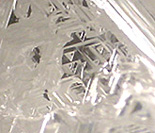 *
* 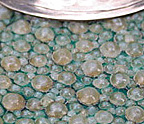 *
* 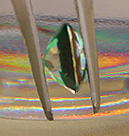 --->(You can find descriptions/explanations of these
pictures at the bottom of this page)<---
Want to know more?
Read on...
Hello, I'm Barbara
Smigel .....
--->(You can find descriptions/explanations of these
pictures at the bottom of this page)<---
Want to know more?
Read on...
Hello, I'm Barbara
Smigel .....
WELCOME TO MY FREE
GEMOLOGY COURSE
If you're interested in learning about gemology
from a scientific rather than from a commercial or artistic viewpoint, then you are in the
right place (not that either art or commerce are unimportant or will
be ignored, they just won't be our main focus.)
Below are a series of lessons that I've
developed as part of a course that I teach at College of Southern
Nevada, where I'm an Emeritus Professor. But you
don't need to be a registered student to use these materials!
As you go through the lectures and essays, you'll see references to
text readings, homework assignments, self quizzes, discussions, and
exams which are meant for the registered
students only.
The down side is that you
won't be able to access the actual course website and the materials
posted there, unless you are a registered
student. The up side is that you're welcome to freely browse the
contents located here, and there are no tests, grades, or time
schedules to worry about. I've posted a sample course syllabus for
your information, but none of the rules, timelines, or expectations
listed therein apply to you, the casual visitor or independent
student. (See below if you would like to register, for credit, for a
future course).
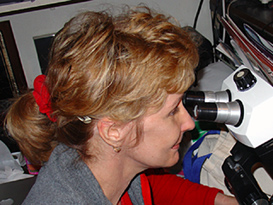 Introduction to
Gemology: Barbara Smigel, PhD, GG.
Introduction to
Gemology: Barbara Smigel, PhD, GG.
Web Lectures: These are the heart and soul of the course. As some
of them are fairly lengthy, and all contain many pictures, depending
on your connection speed, they may take a few minutes to
download.
Web Essays: These short, to moderate length,
one-topic, pictoral essays supplement and enrich the web lectures for
each lesson.
- Lesson 1:
Chrome
Diopside, Jet,
Benitoite,
Aquamarine,
Rock Crystal
Quartz, Red
Beryl,
Coral,
Ivory,
Danburite
- Lesson 2:
Labradorite,
Mexican
Opal,
Chrysocolla
Chalcedony,
Morganite,
Charoite,
Tsavorite
- Lesson 3:
Moldavite,
Drusy
Gems,
Fire
Agate,
Nephrite,
Botryoidal
Gems,
Hardness,
Jadeite,
Specific
Gravity
- Lesson 4:
Pyrite,
Andalusite,
Peridot,
Ruby,
Rhodocrosite,
Dispersion,
Tanzanite,
Fluorite,
Chrysoprase
- Lesson
5:
Included
Quartz,
Rubellite Tourmaline
- Lesson 6:
Aventurescent
Gems,
Chatoyance,
Star
Stones, Color
Change Stones,
Iridescent
Gems,
Cat'seye
Stones
- Lesson 7:
Considering
Faceting,
Less
Common Organic Gems
- Lesson 8:
Tanzanite,
Zircon,
Blue Topaz,
Iolite,
Oregon
Sunstone,
Spinel,
Uvarovite
Garnet
- Lesson 9:
Synthetics,
Simulants and Fakes,
Assembled
Stones,
Natural
Pearls,
Freshwater
Cultured Pearls,
Saltwater
Cultured Pearls
- Lesson 10:
Sugilite,
Malachite,
Turquoise,
Fossil
Plants as Gems,
Birthstones,
Lapis Lazuli,
Meteorites as
Gems
Pronunication
Guide: Alphabetically
listed audio files with the correct pronunciation for some of the
terms in the Web Lectures and Essays:
Bonus
information:
Survey of Gemstones
A-Z (Very little lecturing
here, just a bunch of cool pictures of common and rare gems with a
few bullet points on each), downloads as Powerpoint presentation in
pdf format.
Text Books and Reading
Assignments: These are not
absolutely necessary for enjoyment of the course materials, but as
they are referred to in the lectures, some of you might like to have
them. Each is available inexpensively from Amazon.com, and other, on
and off-line, booksellers.
- The Smithsonian
Handbook of Gemstones, Cally Hall & John Taylor, Dorling
Kindersley, 2002
- Simon and
Schuster's Guide to Gems and Precious Stones, Kennie Lyman,
Editor, Simon and Schuster, 1986
- Assignments:
- Lesson 1: Hall: pgs. 6-11,
Lyman: pgs. 10-13 & 272
- Lesson 2: Hall: -- , Lyman: pg.
41
- Lesson 3: Hall: pgs. 16 - 19,
Lyman: pgs. 34 - 37, 42 - 47 & 55
- Lesson 4: Hall: pgs. 20 - 22
& 38 - 47, Lyman: --
- Lesson 5: Hall: pgs. 24 - 25,
Lyman: pgs. 52 - 55
- Lesson 6: Hall: pg. 23, Lyman:
pgs. 112 - 115 & 222 - 229
- Lesson 7: Hall: pgs. 26 - 31,
Lyman: pgs. 58 - 68
- Lesson 8: Hall: pg. 37, Lyman:
---
- Lesson 9: Hall: pgs. 34-37,
Lyman: pgs. 316 - 328
- Lesson 10: Hall: pgs. 12 - 15,
Lyman: pgs. 37 - 41
Contact: [email protected]
(REGISTRATION FOR
CREDIT)
This course is
offered at CSN, http://www.csn.edu/ as Geology 115, Introduction to Gemology,
and is an ongoing offering through our Distance Education Department
via the internet for anyone, regardless of their geographic location,
(in the US or not).
 *
*  *
*  *
* 
What are they? The leftmost picture is
a magnification of a type of inclusion characteristic of peridot
gemstones, particularly those from Arizona, they are called lily
pads, although I must admit "flying saucers"comes to my mind. This
picture is described and discussed in Lesson 5: "Magnification and
What it Reveals". Secondly, we see part of the magnified surface of a
rough diamond, the triangular markings, known as "trigons" are
diagnostic to diamond. This image finds use in Lesson 5 and also in
Lesson 8: "Synthetics and Simulants". Next we see a 10x magnified
picture of the lid of a 1920's Art Deco cosmetic jar. It is covered
with shagreen, which is a leather made from sharkskin -- an unusual,
but valuable. organic material sometimes used in jewelry and
ornamental items. You'll learn more about shagreen in the essay on
Unusual Organics. Finally, you are seeing a view of a type of
simulated emerald widely sold under the trade name "Soude" or
sometimes "spinel triplet". It consists of two colorless layers of
glass or white spinel with green glass or even green glue in between.
In Lesson 8 we will see a view of this gem as it would appear in
jewelry (perfectly uniformly green), and, as in this photo, immersed
in water and photographed from the side revealing its "sandwich
like"nature.
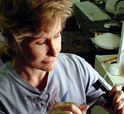 ******
******
*
*
*


